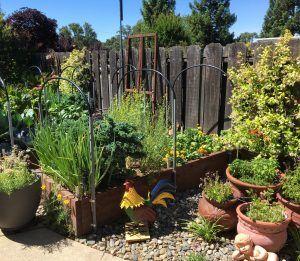Sponsored by:
Planting a vegetable garden has the romantic appeal of getting back to the land and to put our hands onto the soil. In order to maximize your experience, planning and preparation is the first order of the day.
The first thing to do is choose your garden site, no more than 100 feet from your house. Plotting your site out on graph paper helps to visualize what you want. Raised beds are recommended in our area, since predation is a serious issue; but don’t be intimidated if your budget is tight for this preparatory phase. Chicken wire is a cheap material for fencing. Netting is inexpensive and can be used year after year. PVC piping can be used to frame your garden beds and will also last for many years. If raised beds exceed your budget, kiddie pools or old bathtubs will do and you won’t need the hardware cloth under them, just drill a few small holes for drainage.
For those who want to invest more, planning a raised bed system that has a 6-foot-tall frame for netting to keep birds out, and a ¼” hardware cloth underneath the bed to keep small rodents out. It is worth the cost and effort, and will hold up for up to 15 years. Plan for room to walk around your beds and minimize the width of the bed to four feet wide. Fencing may be necessary to keep out rabbits and deer or any larger animals. If you only have room for a patio garden in pots, you may not have to go to these protective lengths, but you should make sure that your plants get at least 6 hours a day of full sun. A drip irrigation system will be a great time saver and depending on the system, can be easy and affordable to install. Most systems have a DIY option.
Next, you will want to consider your soil. You will need nutrient-rich dirt that has good drainage. There are many amendments available. You need a good balance of Nitrogen, which promotes leafing, Phosphorus for rooting and fruiting, and potassium that helps plants absorb nutrients. Soil in the foothills tends to be acidic. You may need to add some oyster shell to bring your PH up to 6.5-7.5.
Now for the vegetables! How much will you really eat? It’s easier to plant too much than too little. If you are gardening for the first time, it’s best to start small. Remember to allow for recommended spacing. Some plants, such as onions, need little room to grow, while others such as zucchinis and melons will sprawl all over your beds. Also, some leafy plants, such as lettuce, kale, chard, collards and spinach can give a continuous yield when you pick only the outer leaves, leaving the centers growing to provide for additional harvests.
Gardens in our area can be year-round, but if you grow in all seasons, remember to use frost cloth to protect the plants from freezing. There is an excellent Foothill Planting Guide available online. The link for that is the last one at the bottom of this article. To promote good soil composition, consider letting 1 or 2 of your beds to go fallow for a season so that they can rejuvenate. You can cover these in a layer of horse manure, or other amendment and add a good layer of straw over that. This helps to increase the loaminess of your soil. Happy Gardening!
Wendy Kubow is a University of California Cooperative Extension Master Gardener of Calaveras County.
UCCE Master Gardeners of Tuolumne and Calaveras Counties can answer home gardening questions. Call 209-533-5912 or fill out our easy-to-use problem questionnaire here. Check out our website here. You can also find us on Facebook.
"vegetable" - Google News
February 14, 2021 at 11:35PM
https://ift.tt/3po4m3A
How To Plan A Vegetable Garden In The Sierra Foothills - MyMotherLode.com
"vegetable" - Google News
https://ift.tt/2CyIOeE
https://ift.tt/3aVzfVV
Bagikan Berita Ini















0 Response to "How To Plan A Vegetable Garden In The Sierra Foothills - MyMotherLode.com"
Post a Comment